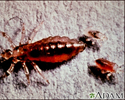Relapsing fever
Tick-borne relapsing fever; Louse-borne relapsing fever
Relapsing fever is a bacterial infection transmitted by a louse or tick. It is characterized by repeated episodes of fever.
Causes
Relapsing fever is an infection caused by several species of bacteria in the Borrelia family.
There are two major forms of relapsing fever:
- Tick-borne relapsing fever (TBRF) is transmitted by the ornithodoros tick. It occurs in Africa, Spain, Saudi Arabia, Asia, and certain areas in the western United States and Canada. The bacteria species associated with TBRF are Borrelia duttonii, Borrelia hermsii, and Borrelia parkeri.
- Louse-borne relapsing fever (LBRF) is transmitted by body lice. It is most common in Asia, Africa, Central and South America. The bacteria species associated with LBRF is Borrelia recurrentis.
Sudden fever occurs within 2 weeks of infection.
- In TBRF, multiple episodes of fever occur, and each may last up to 3 days. People may not have a fever for up to 2 weeks, and then it returns.
- In LBRF, the fever commonly lasts 3 to 6 days. It is often followed by a single, milder episode of fever.
In both forms, the fever episode may end in crisis. This consists of shaking chills, followed by intense sweating, falling body temperature, and low blood pressure. This stage may result in death.
In the United States, TBRF often occurs west of the Mississippi River, particularly in the mountains of the West and the high deserts and plains of the Southwest. In the mountains of California, Utah, Arizona, New Mexico, Colorado, Oregon, and Washington, infections are usually caused by Borrelia hermsii and are often picked up in cabins in forests. The risk may now extend into the southeastern United States.
LBRF is mainly a disease of the developing world. It is currently seen in Ethiopia and Sudan. Famine, war, and the movement of refugee groups can result in clusters of LBRF epidemics.
Symptoms
Symptoms of relapsing fever include:
- Bleeding
- Headache
- Joint aches, muscle aches
- Nausea and vomiting
- Sagging on one side of the face (facial droop)
- Stiff neck
- Sudden high fever, shaking chills, seizure
- Weakness, unsteadiness while walking
- Coma
Exams and Tests
Relapsing fever should be suspected if someone coming from a high-risk area has repeated episodes of fever. This is largely true if the fever is followed by a crisis stage, and if the person may have been exposed to lice or soft-bodied ticks.
Tests that may be done include:
- Blood smear to determine the cause of the infection
- Blood antibody tests (sometimes used, but their usefulness is limited)
Treatment
Antibiotics, including penicillin and tetracycline, are used to treat this condition.
Outlook (Prognosis)
People with this condition who have developed a coma, heart inflammation, liver problems, or pneumonia are more likely to die. With early treatment, the death rate is reduced.
Possible Complications
These complications may occur:
- Drooping of the face
- Coma
- Liver problems
- Inflammation of the thin tissue that surrounds the brain and spinal cord
- Inflammation of the heart muscle, which may lead to irregular heart rate
- Pneumonia
- Seizures
- Stupor
- Shock related to taking antibiotics (Jarisch-Herxheimer reaction, in which the rapid death of very large numbers of Borreliae bacteria causes shock)
- Weakness
- Widespread bleeding
When to Contact a Medical Professional
Contact your health care provider right away if you develop a fever after returning from a trip. Possible infections need to be investigated in a timely manner.
Prevention
Wearing clothing that fully covers the arms and legs when you are outdoors can help prevent TBRF infection. Insect repellent such as DEET on the skin and clothing also work. Tick and lice control in high-risk areas is another important public health measure.
References
Horton JM. Relapsing fever caused by Borrelia species. In: Bennett JE, Dolin R, Blaser MJ, eds. Mandell, Douglas, and Bennett's Principles and Practice of Infectious Diseases. 9th ed. Philadelphia, PA: Elsevier; 2020:chap 240.
Petri WA. Relapsing fever and other Borrelia infections. In: Goldman L, Cooney KA, eds. Goldman-Cecil Medicine. 27th ed. Philadelphia, PA: Elsevier; 2024:chap 297.
Review Date: 11/10/2024






